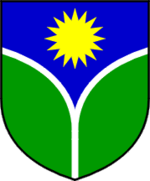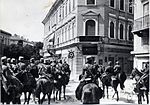Šempeter pri Gorici
Cities and towns in the Slovene LittoralGoriška statistical region geography stubsItaly–Slovenia border crossingsPages including recorded pronunciationsPages with Slovene IPA ... and 1 more
Populated places in the Municipality of Šempeter-Vrtojba

Šempeter pri Gorici (pronounced [ʃɛmˈpeːtəɾ pɾi ɡɔˈɾiːtsi] or [ʃəmˈpeːtəɾ pɾi ɡɔˈɾiːtsi]; Italian: San Pietro di Gorizia. Also Localy known as simply just Šempeter) is a town and the administrative centre of the Municipality of Šempeter-Vrtojba in the Slovene Littoral region of Slovenia. There is a border crossing into the Italian town of Gorizia. Through most of its history, it was linked to the town of Gorizia (Slovene: Gorica), which is now in Italy, whence also its name, literally meaning 'St. Peter near Gorizia'. Since 1947, it has been gravitating towards the newly established town of Nova Gorica, with which it forms a continuous conurbation.
Excerpt from the Wikipedia article Šempeter pri Gorici (License: CC BY-SA 3.0, Authors, Images).Šempeter pri Gorici
Ulica Nikole Tesle, Šempeter-Vrtojba
Geographical coordinates (GPS) Address Nearby Places Show on map
Geographical coordinates (GPS)
| Latitude | Longitude |
|---|---|
| N 45.928377777778 ° | E 13.637825 ° |
Address
Ulica Nikole Tesle 15a
5290 Šempeter-Vrtojba
Slovenia
Open on Google Maps








